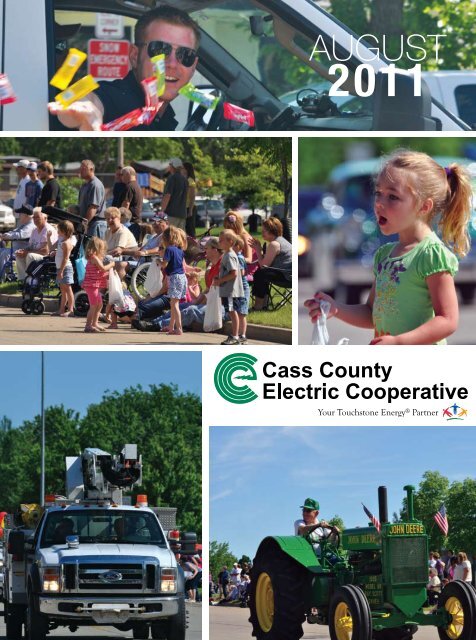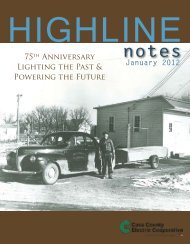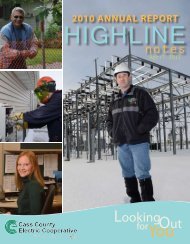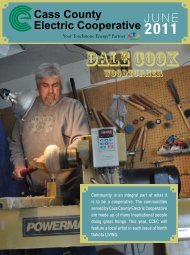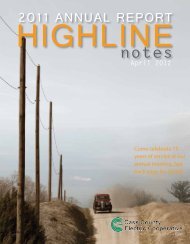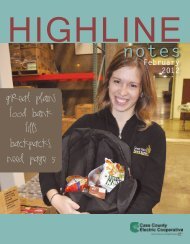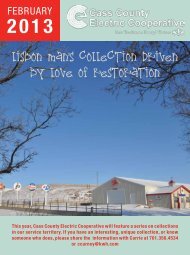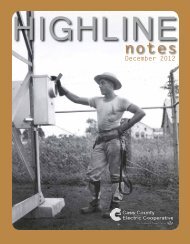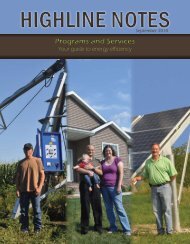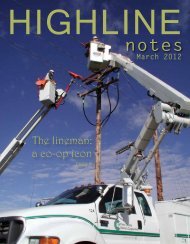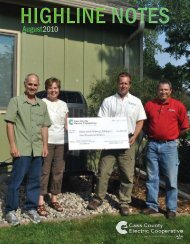AUGUST - Cass County Electric Cooperative
AUGUST - Cass County Electric Cooperative
AUGUST - Cass County Electric Cooperative
Create successful ePaper yourself
Turn your PDF publications into a flip-book with our unique Google optimized e-Paper software.
august<br />
2011
Kay Hilde,<br />
Artist<br />
Community is an integral<br />
part of what it is to be a<br />
cooperative. The communities<br />
served by <strong>Cass</strong> <strong>County</strong> <strong>Electric</strong><br />
<strong>Cooperative</strong> are made up of<br />
many inspirational people<br />
doing great things. This year,<br />
CCEC will feature a local<br />
artist in each issue of North<br />
Dakota LIVING.
&<br />
color, words<br />
creativity<br />
Colorful, energetic, optimistic. These<br />
words describe Kay Hilde’s art, her home<br />
and, well, her. She’s a local woman with<br />
a cheerful, worldly outlook. Her laugh is<br />
genuine and if it is possible for someone to<br />
pour themselves into their work, she does<br />
it. Kay’s personality shines through in the<br />
lively colors that swirl through her canvases.<br />
Upbeat words complement her pieces.<br />
Always an artist<br />
Kay grew up on a farm south of Moorhead. She<br />
is the youngest of four children and spent a lot<br />
of time on her own – wandering, exploring,<br />
imagining. “My brain had plenty of room to<br />
be creative,” she said of her childhood, “Dad<br />
would give me a piece of wood and a paint<br />
brush and I thought it was great.”<br />
She remembers writing poetry at a young<br />
age and making her own greeting cards. Art<br />
was always a part of her life whether it was<br />
with paint or with words. After graduating<br />
from Moorhead High School, she went on<br />
to major in art at Minnesota State University<br />
Moorhead, but by the time she graduated,<br />
Kay had changed her major to marketing<br />
and advertising. She just wasn’t at a point<br />
yet where she could commit completely to<br />
art, besides, words are a form of art and she<br />
excels in using them. Look at her current<br />
greeting cards and you will see creativity in<br />
the textual style.<br />
Her career throughout the next years would<br />
take her to different areas of media and<br />
marketing. Around 1988, when she had the<br />
first of her two children, she decided to go<br />
a different route. She and a friend started<br />
Whimsy Wear, making specialty T-shirts.<br />
This business lasted 10 years, evolving into<br />
a screen printing business and then it ran<br />
its course and Kay moved on. Now, she’s an<br />
artist who also works at Candlewood Suites<br />
in Fargo.<br />
In the last five years, she focused on art<br />
again, combining her love of words into<br />
canvas paintings. The paintings were first<br />
displayed in a local coffee shop. Kay has<br />
now expanded her signature art to purses,<br />
wallets, and even furniture. She also does<br />
custom painting and design. She is the 2010<br />
recipient of the YWCA Woman of the Year in<br />
the arts and communication category.<br />
Everyone is<br />
creative<br />
Kay truly believes everyone is<br />
creative and dislikes hearing<br />
people say they are not. She pays<br />
special attention to children –<br />
especially her great-nieces and<br />
nephews. She’s witnessed how<br />
children that color inside the lines<br />
are rewarded for following the<br />
rules and standards, while children<br />
that color outside the lines are told<br />
to try and stay inside of them.<br />
She recently challenged a young<br />
nephew, who likes to stay in the<br />
lines, to close his eyes and pick<br />
a crayon out of the box and use it<br />
to color the leaves on the tree. He<br />
picked purple and although it was<br />
hard for him to break the color<br />
“rule” he was amazed by how<br />
“funky” it turned out.<br />
These observations have led Kay<br />
to do research on right brain/left<br />
brain tendencies and she will soon<br />
teach a Moorhead Community<br />
Education course on her findings.<br />
Back to her roots<br />
When Kay was a child, her father<br />
called her Binnie the Pooh, which<br />
evolved into a lifelong family<br />
nickname of Binnie. On her farm, she spent<br />
countless hours roaming and imagining and<br />
she dreams of a return. Her brothers still farm<br />
and live on the farmstead and she fantasizes<br />
of turning one of the grain bins into an art<br />
studio. It would be a unique sanctuary in a<br />
place that is so dear to her. Until then, she’ll<br />
continue to turn her kitchen into an art studio<br />
and use color, words and creativity.
Freezers, Food &<br />
Energy Use<br />
When the local grocery store is having a sale on meat<br />
and poultry, many people tend to stock up on items<br />
and put them in the freezer. While it may seem to be a<br />
money-saving experience upfront, after considering the<br />
following, it may prove to increase energy costs. The<br />
saying “buy what you eat and eat what you buy” may be<br />
tough, but it may be worth paying attention to.<br />
There are government guidelines for how long certain items<br />
should be frozen. With more lengthy times in the freezer,<br />
the quality of the food suffers. According to Foodsafety.<br />
gov, under the United States Department of Agriculture<br />
(USDA), there are suggested guidelines for the quality of<br />
the food and there is nothing recommended to be frozen<br />
for more than a year. There are many food categories listed<br />
on this website and you might be surprised at some of the<br />
suggestions.<br />
There are many factors that can affect the quality of the<br />
frozen food, including packaging, the freshness of the food<br />
at the time of freezing, and the temperature of the freezer.<br />
It is also important to understand that the “quality of the<br />
food” can be somewhat subjective and will vary from<br />
person to person. Thawing food safely will also determine<br />
the quality.<br />
Quality aside, take it a step further and also consider how<br />
much energy it takes to keep that food frozen, especially<br />
if the plan is to keep it frozen for long periods of time. The<br />
amount of energy used depends on the type of freezer<br />
you have and the temperature setting. For example,<br />
referring to the energy for the freezer portion: top freezer<br />
models use a little less energy than a side by side model,<br />
but the bottom freezer models will use less than the top<br />
freezer models. These types of freezers should be used<br />
on a short-term basis. Consider using a deep freezer for<br />
longer storing time. The temperature it is set at is also<br />
important; the recommendations are to keep the deep<br />
freeze at 0°F and freezer at 5°F. How much food is stored<br />
in the freezer is another important consideration. If a<br />
frozen turkey is the only thing in the freezer, it may make<br />
more sense to unplug the freezer until it is stocked more.<br />
If the food is not used and must be thrown, that energy<br />
was wasted. The point is that there is a relationship<br />
between price, how long food is stored, and the energy<br />
that was used to store it.<br />
When stocking up on a food from your butcher or<br />
wholesale food store, it is a good idea to be realistic about<br />
how much you can actually use within the guidelines of<br />
the suggested freezer life time.<br />
Category Food refrigerator Freezer<br />
(40 °F or below) (0 °F or below)<br />
Salads Egg, chicken, ham, tuna & macaroni salads 3 to 5 days Does not freeze well<br />
Hot dogs opened package 1 week 1 to 2 months<br />
unopened package 2 weeks 1 to 2 months<br />
Luncheon meat opened package or deli sliced 3 to 5 days 1 to 2 months<br />
unopened package 2 weeks 1 to 2 months<br />
Bacon & Sausage Bacon 7 days 1 month<br />
Sausage, raw 1 to 2 days 1 to 2 months<br />
Hamburger & Other Hamburger, ground beef, turkey, 1 to 2 days 3 to 4 months<br />
Ground Meats veal, pork, lamb, & mixtures of them<br />
Fresh Beef, Veal, Steaks 3 to 5 days 6 to 12 months<br />
Lamb & Pork Chops 3 to 5 days 4 to 6 months<br />
Roasts 3 to 5 days 4 to 12 months<br />
Fresh Poultry Chicken or turkey, whole 1 to 2 days 1 year<br />
Chicken or turkey, pieces 1 to 2 days 9 months<br />
Soups & Stews Vegetable or meat added 3 to 4 days 2 to 3 months<br />
www.foodsafety.gov
Look up during<br />
hectic harvest<br />
Harvest season is one of the busiest times of year for<br />
farmers – and among the most dangerous. Before taking<br />
to the fields, farmers should be aware of overhead power<br />
lines and to keep equipment and extensions far away<br />
from them.<br />
<strong>Electric</strong>al equipment around the fields, such as power<br />
lines in the end row areas, may get overlooked during<br />
such a hectic time of year. However, failure to notice<br />
overhead power lines can be a deadly oversight.<br />
Safe <strong>Electric</strong>ity urges farm workers to heed<br />
these safety measures:<br />
• Review all farm activities and work practices that<br />
will take place around power lines and remind all<br />
workers to take precautions.<br />
• Know the location of power lines and keep farm<br />
equipment at least 10 feet away from them.<br />
• Use care when raising augers or the bed of a grain<br />
truck. It can be difficult to estimate distance and<br />
sometimes a power line is closer than it looks. When<br />
moving large equipment or high loads near a power<br />
line, always use a spotter, or someone to help make<br />
certain that contact is not made with a line.<br />
• Always lower portable augers or elevators to their<br />
lowest possible level – under 14 feet – before<br />
moving or transporting them. Variables like wind,<br />
uneven ground, shifting weight or other conditions<br />
can combine to create an unexpected result.<br />
• Be aware of increased height when loading<br />
and transporting larger modern tractors with<br />
higher antennas.<br />
• Never attempt to raise or move a power line to clear<br />
a path!<br />
• As in any outdoor work, be careful not to raise any<br />
equipment such as ladders, poles or rods into<br />
power lines. Remember, nonmetallic materials<br />
such as lumber, tree limbs, tires, ropes and hay will<br />
conduct electricity depending on dampness and<br />
dust and dirt contamination.<br />
• Use qualified electricians for work on drying<br />
equipment and other farm electrical systems.<br />
If danger looms...<br />
Even the best plans often go awry and your electric<br />
cooperative wants farm workers to be prepared if their<br />
equipment does come in contact with power lines.<br />
“It’s almost always best to stay in the cab and call for<br />
help,” says Molly Hall of Safe <strong>Electric</strong>ity, a program of the<br />
Energy Education Council. “If the power line is energized<br />
and you step outside, your body becomes the path to the<br />
ground and electrocution is the result. Even if a line has<br />
landed on the ground, there is still potential for the area<br />
to be energized. Warn others who may be nearby to stay<br />
away and wait until the electric utility arrives to make<br />
sure power to the line is cut off.”<br />
There are solutions for leaving the cab if necessary, as in<br />
the case of fire or electrical fire.<br />
“In that scenario, the proper action is to jump – not step<br />
– with both feet hitting the ground at the same time,” Hall<br />
said. “Do not allow any part of your body to touch the<br />
equipment and the ground at the same time. Hop to safety,<br />
keeping both feet together as you leave the area.”<br />
Once you get away from the equipment, never attempt<br />
to get back on or even touch the equipment. Many<br />
electrocutions occur when operators try to return to the<br />
equipment before the power has been shut off.
Insulation<br />
Truths<br />
There is a knock at the door. You open to find<br />
someone offering to measure your insulation<br />
and they offer you services to increase your<br />
insulation and help you to take advantage of<br />
the state utility rebate program. A certain<br />
level of insulation is recommended when<br />
it comes to energy efficiency and proper<br />
insulation can indeed save you money on<br />
your heating bills. There is rebate money<br />
available until the end of 2011 for proper<br />
insulation. It is important that you understand<br />
the facts and requirements before agreeing<br />
to have insulation installed. Here they are:<br />
What is recommended insulation? Many<br />
homes - particularly those that are more<br />
than 20 years old - lose lots of heat because<br />
of poor insulation, according to the DOE. And<br />
because heat rises, the No. 1 problem area is<br />
your attic. (Other areas that could need more<br />
insulation are your foundation walls, slab<br />
floors, above grade walls, rim or band joist,<br />
and crawl space.)<br />
Insulation is measured in something called<br />
an “R-value.” The higher the R-value, the<br />
greater the insulation. If you have R-19 or<br />
less insulation in your attic, consider bring<br />
it up to R-49 in colder climates, like North<br />
Dakota.<br />
What qualifies for the state rebate? The<br />
current level of insulation in the home needs<br />
to be less than R-20. After installation, the<br />
level must be R-49. The rebate is 50% of<br />
cost up to $400 if installed by a contractor<br />
and 50% of cost up to $200 if self-installed.<br />
How does a CCEC member receive the<br />
state rebate? A CCEC member should<br />
contact a contractor to do the installation.<br />
(Member can also call CCEC for advice.) The<br />
contractor will complete work and fill out<br />
the state rebate form and then submit form<br />
to CCEC. CCEC will verify installation. The<br />
member will then receive a check for the<br />
appropriate rebate amount.<br />
Remember to make sure your attic is wellsealed<br />
before adding insulation! If you<br />
choose to add attic insulation, be sure to seal<br />
air leaks between your home and attic. Heat<br />
will travel through your attic by two different<br />
means. The first way is by heat transmission.<br />
Whenever the attic is colder than the house,<br />
heat will flow from the house to the attic<br />
through the drywall, plaster or paneling that<br />
covers the ceiling.<br />
There is also air leakage to think about. Air<br />
can leak around your chimney, plumbing<br />
pipes, wires and other penetrations in your<br />
ceiling. Air leakage can account for a large<br />
portion of your heating bill.<br />
Insulation reduces heat transmission and<br />
air sealing reduces air leakage. These two<br />
tasks should be done at the same time. Most<br />
insulation slows heat transmission but doesn’t<br />
do much for sealing air leaks because it is a<br />
loose material and air passes right through it.<br />
If you insulate without air sealing, you may not<br />
be able to seal the air leaks once you cover<br />
them with insulation. Before you insulate your<br />
attic, locate each and every penetration in the<br />
ceiling of your home.<br />
TYPES OF INSULATION<br />
Although insulation can be made from<br />
a variety of materials, it usually comes<br />
in four types. Each type has different<br />
characteristics.<br />
• Rolls and batts – or blankets – are<br />
flexible products made from mineral<br />
fibers, such as fiberglass and rock<br />
wool. They are available in widths<br />
suited to standard spacings of wall<br />
studs and attic or floor joists.<br />
• Loose-fill insulation is usually made<br />
of fiberglass, rock wool or cellulose<br />
in the form of loose fibers or fiber<br />
pellets. It should be blown into spaces<br />
using special equipment. The blown-in<br />
material conforms readily to building<br />
cavities and attics. Therefore, loosefill<br />
insulation is well-suited for places<br />
where it is difficult to install other<br />
types of insulation.<br />
• Rigid foam insulation is typically more<br />
expensive than fiber insulation. But<br />
it’s effective in buildings with space<br />
limitations and where higher R-values<br />
are needed. Foam insulation R-values<br />
range from R-4 to R-6.5 per inch of<br />
thickness, which is up to two times<br />
greater than most other insulating<br />
materials of the same thickness.<br />
• Foam-in-place insulation can be blown<br />
into walls and reduces air leakage,<br />
if blown into cracks, such as around<br />
window and door frames.<br />
INSULATION TIPS<br />
• Consider factors such as climate,<br />
building design and budget when<br />
selecting insulation R-values for your<br />
home.<br />
• Use higher-density insulation, such as<br />
rigid foam boards, on exterior walls<br />
and in cathedral ceilings.<br />
• Ventilation helps with moisture control<br />
and reducing summer cooling bills.<br />
Attic vents can be installed along the<br />
entire ceiling cavity to help ensure<br />
proper air flow to make a home more<br />
comfortable and energy efficient. Do<br />
not ventilate your attic if you have<br />
insulation on the underside of the roof.<br />
Check with a qualified contractor.<br />
• Recessed light fixtures can be a major<br />
source of heat loss, but you need to be<br />
careful how close you place insulation<br />
next to a fixture unless it is designed<br />
for direct insulation contact.<br />
• As specified on the product packaging,<br />
follow the product instructions on<br />
installation and wear the proper<br />
protective gear when installing<br />
insulation.
Take advantage of the state utility rebate<br />
program, but hurry! The program ends<br />
in December or when funds run out.
NEWS<br />
<strong>Cooperative</strong><br />
Steve Gregerson and Neil Stenshoel retired June 1. Gregerson had worked at CCEC since<br />
1974, most recently as a design/construction supervisor. Stenshoel had worked at CCEC since<br />
1980, most recently as a line crew foreman.<br />
Steve Peterson transferred to the Fargo East Service Center from Arthur – he is a journeyman<br />
lineworker.<br />
Luke Nefzger has been hired as a full-time lineworker at the Arthur Service Center. He<br />
previously worked at CCEC as a seasonal apprentice lineworker.<br />
Daren Wawrzyniak has been hired as a power control technician at the Fargo Service Center.<br />
Daren has worked as a journeyman electrician since 1996 in Fargo.<br />
CCEC’s Trudy Wanner and Jeremy Mahowald hosted a power plant tour on June 14 and 15.<br />
A total of 46 members and eight employees of Border States <strong>Electric</strong> attended. In addition to<br />
touring the Milton R. Young station, the group also toured the Ashtabula Wind Energy Center.<br />
Mike Mead and Jocelyn Lura presented at the <strong>Cass</strong>elton Farm Safety Just For Kids – presenting<br />
on electrical safety, energy conservation and renewable energy.<br />
Energy efficiency<br />
rebates still available<br />
Does your heating system need replacing?<br />
Do you want to add insulation? Are you<br />
building a new home? Rebate money is<br />
still available through the<br />
North Dakota Utility Rebate<br />
Program. The program ends<br />
when the money runs out or<br />
at the end of the year, so act now! Rebates are<br />
available on ENERGY STAR qualified heating,<br />
central air conditioners, water heaters,<br />
insulation, commerical lighting, air-source<br />
heat pumps, geothermal heat pumps, and<br />
renewables. Residential consumers have<br />
a $5,000 cap and commercial consumers,<br />
a $15,000 cap. CCEC<br />
has processed over<br />
$466,460 in rebates!<br />
Call today for more<br />
information at 701.356.4400 or visit www.<br />
kwh.com. The rebates are now available to<br />
contractors, too!<br />
$522,163<br />
remaining<br />
HEADQUARTERS<br />
3312 42 nd St. S. Suite 200<br />
Fargo, N.D. 58104<br />
BOARD OF DIRECTORS<br />
Wendy Loucks, Chairman<br />
Russell Berg, Vice Chairman<br />
John Froelich, Secretary<br />
Sid Berg, Treasurer<br />
Douglas Anderson<br />
Bill Bertram<br />
Robert Huether<br />
Steve Swiontek<br />
Jeff Triebold<br />
EXECUTIVE STAFF<br />
Scott Handy, President/CEO<br />
Brad Schmidt, Senior Vice<br />
President of Transmission and<br />
Distribution Services<br />
Chad Sapa, Vice President of<br />
Corporate Services/CFO<br />
Marshal Albright, Vice President of<br />
Member and Energy Services<br />
Tim Sanden, Vice President of<br />
Information Technology/CIO<br />
EDITOR<br />
Carrie Carney<br />
DESIGNER<br />
Jocelyn Lura<br />
POWER CONTROL/ SYSTEM<br />
MONITORING HOURS<br />
24 hours a day, 7 days a week,<br />
365 days a year, our power control<br />
center monitors our system and<br />
handles outage situations. If you<br />
are a <strong>Cass</strong> <strong>County</strong> <strong>Electric</strong> member<br />
and encounter an emergency or<br />
power outage, please call<br />
(701) 356-4499 or (888) 277-4424.<br />
WEB SITE<br />
www.kwh.com<br />
E-MAIL<br />
info@kwh.com<br />
BILLING QUESTIONS OR START/<br />
STOP SERVICE<br />
(701) 356-4430 or<br />
(888) 277-4422<br />
OTHER QUESTIONS<br />
701-356-4400 or 800-248-3292<br />
CALL BEFORE YOU DIG<br />
811 or 800-795-0555


